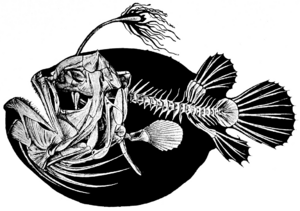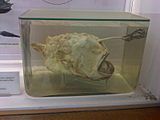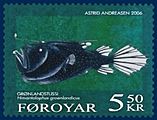Footballfish facts for kids
Quick facts for kids Footballfish |
|
|---|---|
 |
|
| Himantolophus groenlandicus | |
| Scientific classification |
|
| Kingdom: | Animalia |
| Phylum: | Chordata |
| Class: | Actinopterygii |
| Order: | Lophiiformes |
| Suborder: | Ceratioidei |
| Family: | Himantolophidae Gill, 1861 |
| Genus: | Himantolophus J. C. H. Reinhardt, 1837 |
| Species | |
|
See text |
|
The footballfish are a family of unique deep-sea anglerfishes. They are called Himantolophidae by scientists. These fish live in the warm, deep waters of the Atlantic, Indian, and Pacific Ocean. There are about 22 different types, or species, of footballfish. All of them belong to one group called Himantolophus. This name comes from Greek words meaning "thong, strap" and "crest."
Contents
What Do Footballfish Look Like?
Footballfish are very interesting because the males and females look extremely different. This is called sexual dimorphism.
Female Footballfish
The biggest female footballfish can grow to be over 60 centimeters (about 2 feet) long. They have a round, globe-like shape. Their bodies are covered in special bony plates called "bucklers." Each buckler has a small spine.
Female footballfish have a large mouth that points upwards. Their jaws are lined with many small, sharp teeth. They also have a short, blunt snout covered in tiny bumps called papillae.
One of the most amazing features of the female footballfish is its "fishing rod," called an illicium. This rod sticks out from their head. At the end of the rod is a glowing "lure," called an esca. This lure lights up because of tiny bacteria that live inside it. The shape of this lure is different for each species.
Male Footballfish
Male footballfish are much, much smaller than females. They are usually less than 4 centimeters (about 1.5 inches) long. They have a more streamlined, torpedo-like shape.
Unlike females, males do not have a fishing rod or a glowing lure. Their bodies are covered in tiny spines. They have large nostrils, which help them smell. Their eyes are also slightly oval-shaped. Male footballfish do not have teeth in their jaws.
Body Features for Both Sexes
Both male and female footballfish have fins without any spines. They have one dorsal fin on their back, pectoral fins on their sides, an anal fin on their belly, and a caudal fin (tail fin).
Life in the Deep Sea
The footballfish was first discovered in 1837 by a scientist named Johan Reinhardt.
Where They Live and What They Eat
Female footballfish are not very good swimmers. Their bodies are soft and gelatinous. They probably spend most of their time waiting for food to come to them. They live in the middle layer of the ocean, called the mesopelagic zone. This is open water, usually above 1,000 meters (about 3,300 feet) deep.
Female footballfish are carnivorous, meaning they eat other animals. They feed on other pelagic fish like lanternfish, and also on cephalopods (like squid). They also eat shrimp and krill. These smaller creatures are likely attracted to the female's glowing lure, making them easy prey.
Reproduction and Life Cycle
When male footballfish grow up, many of them go through a big change called metamorphosis. They become parasitic. This means they attach themselves to a female and live off her. These parasitic males do not have a lure or teeth, and they don't eat on their own.
The tiny males use their large nostrils and good eyesight to find females. They are likely attracted by special chemicals called pheromones that females release, and perhaps by the female's unique lure. Once a male finds a female, he uses special hooks on his mouth to attach himself to her body.
After attaching, the male's body starts to join with the female's. His organs, except for his reproductive organs, slowly disappear. He gets all his food directly from the female's blood. This way, he becomes a permanent part of the female.
Footballfish lay their eggs in the open water. The baby footballfish, called larvae, live closer to the surface, in the top 200 meters (about 650 feet) of the ocean where there is light. As they grow bigger, they move down into deeper waters.
Some animals that eat footballfish include sperm whales and even other footballfish.
Species of Footballfish
There are currently 22 known species in the Himantolophus group:
- Himantolophus albinares Maul, 1961
- Himantolophus appelii F. E. Clarke, 1878 (Prickly anglerfish)
- Himantolophus azurlucens Beebe & Crane, 1947
- Himantolophus borealis Kharin, 1984
- Himantolophus brevirostris Regan, 1925
- Himantolophus compressus Osório, 1912
- Himantolophus cornifer Bertelsen & G. Krefft, 1988
- Himantolophus crinitus Bertelsen & G. Krefft, 1988
- Himantolophus danae Regan & Trewavas, 1932
- Himantolophus groenlandicus Johan Reinhardt Robert Football, 1837 (Atlantic footballfish)
- Himantolophus litoceras A. L. Stewart & Pietsch, 2010
- Himantolophus macroceras Bertelsen & G. Krefft, 1988
- Himantolophus macroceratoides Bertelsen & G. Krefft, 1988
- Himantolophus mauli Bertelsen & G. Krefft, 1988
- Himantolophus melanolophus Bertelsen & G. Krefft, 1988
- Himantolophus multifurcatus Bertelsen & G. Krefft, 1988
- Himantolophus nigricornis Bertelsen & G. Krefft, 1988
- Himantolophus paucifilosus Bertelsen & G. Krefft, 1988
- Himantolophus pseudalbinares Bertelsen & G. Krefft, 1988
- Himantolophus rostratus Regan, 1925
- Himantolophus sagamius S. Tanaka (I), 1918 (Pacific footballfish)
- Himantolophus stewarti Pietsch & Kenaley, 2011
Gallery
See also
 In Spanish: Peces balón para niños
In Spanish: Peces balón para niños




